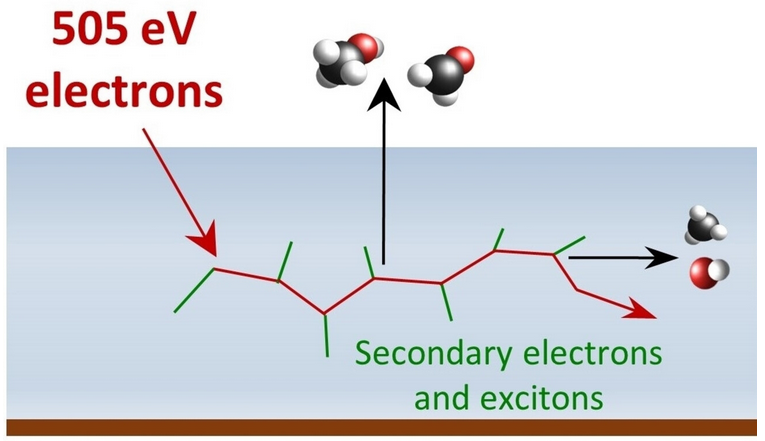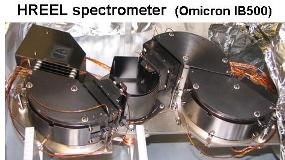Accueil > Équipes scientifiques > Surfaces, Interfaces, Molecules & 2D Materials (SIM2D) > Chimie de surface & électrons lents, 0-50 eV
Chimie de surface & électrons lents, 0-50 eV
Introduction
(french version)
This research theme concerns the study of interactions between electrons (from 1 eV to a few hundred eV) and supported molecular systems and/or semiconductor surfaces. The objective is to understand, at the fundamental level, the interactions between the electron and the deposited adsorbate, as well as the mechanisms involved in the chemical modifications that are generated. The latest methodological developments focus on the identification and measurement of quantitative markers of these induced processes.
These studies are motivated to a large extent by the important role of electron/molecule interactions involved in variety of situations. Indeed, the interaction between a molecular system and energetic radiation releases secondary electrons that contribute to the modification of the physico-chemical properties of the system. Thus our studies are key to several fields : chemistry under radiation ; radiation therapy ; physicochemistry of the environment, interstellar (astrochemistry) and stratospheric environments ; the development of chemical and biological detectors ; the modification and manufacture of devices by nanolithography ; electronic aging of high voltage cables, characterization of surfaces and their adsorbates by LEED, STM, HREELS or X-rays.
Our team is under the SIM2D group of ISMO and is led by experts in the field of surface science and electron-molecule interactions :
Team members SIM2D involved :
 Anne Lafosse, Professeur
Anne Lafosse, Professeur
 Lionel Amiaud, Maître de Conférences (HDR)
Lionel Amiaud, Maître de Conférences (HDR)
 Daniela Torres-Díaz, Doctorante
Daniela Torres-Díaz, Doctorante
Research Partners and Collaborations


Other research partners and european networks
Studies on low-energy electron interaction with the following systems have been performed in our laboratory :

Previous studies by the group dealt with fundamental studies on processes induced by the impact of low-energy electrons on molecular ices especially in the context of interstellar media.

 Self-Assembled Monolayers (SAMs)
Self-Assembled Monolayers (SAMs)
Low-energy electron irradiation to modify SAM surfaces can be an efficient tool in the development of functionalized surfaces for biochemical sensing.
Laboratory Techniques and Equipment
Our laboratory is equipped with the High Resolution Electron Energy Loss Spectrometer (HREELS) housed in an ultra-high vacuum set-up that is also installed with an electron gun, a Quadrupole Mass Spectrometer (QMS), and a closed-cycle helium cryostat. The QMS is useful for Temperature Programmed Desorption (TPD) and Electron Stimulated Desorption (ESD) experiments which, together with the HREELS, provide a wealthy combination of complementary techniques for the characterization of low-energy electron-irradiated adsorbed molecules on surfaces.
 High Resolution Electron Energy Loss Spectroscopy (HREELS), a surface-sensitive technique, allows for the characterization of a sample surface on the basis of the energy loss undergone by electrons colliding with the sample surface. The energy loss spectrum obtained from this technique is related to vibrational excitations of the surface molecules being probed. Composition and orientation of molecules on the surface can be deduced from the energy loss spectra generated from this technique. Excitation functions may also be obtained using this spectrometer by observing specific energy losses as a function of incident electron energy. From these excitation functions, information regarding excitation mechanisms and density of electronic states of substrates can be obtained.
High Resolution Electron Energy Loss Spectroscopy (HREELS), a surface-sensitive technique, allows for the characterization of a sample surface on the basis of the energy loss undergone by electrons colliding with the sample surface. The energy loss spectrum obtained from this technique is related to vibrational excitations of the surface molecules being probed. Composition and orientation of molecules on the surface can be deduced from the energy loss spectra generated from this technique. Excitation functions may also be obtained using this spectrometer by observing specific energy losses as a function of incident electron energy. From these excitation functions, information regarding excitation mechanisms and density of electronic states of substrates can be obtained.
Low-Energy Electron Irradiation utilizes an electron gun capable of producing low-energy electrons that can be exposed directly to the sample. The energy of the electrons released can be adjusted to study modifications on the surface at various electron energies.
The Quadrupole Mass Spectrometer (QMS) housed in the UHV is optimized for the low pressure detection of neutral species. This device can detect fragments desorbing from the surface during electron irradiation.
The Closed-Cycle Helium Cryostat attached to the sample holder can control sample surface temperatures from 20 to 800 K.
The following techniques are also widely used by the group from the combination of tools mentioned above :
Electron Stimulated Desorption (ESD) combines the use of the electron gun and the QMS. In this technique, desorbed fragments are detected during electron-irradiation of the sample. The desorbed fragments are released in gas phase and can be quantified using the QMS.
Irradiation can also be done at lower temperatures with the help of the cryostat to trap desorbed fragments by physisorption. The adsorbed fragments on the surface can then be observed through HREELS. Studying these fragments can elucidate the nature and mechanism of observed electron-induced processes.
Temperature Programmed Desorption (TPD) is a technique in which desorbed species are detected when the sample temperature is increased at a constant rate. It combines the use of the cryostat for temperature control and the QMS for the detection of desorbed species. The desorbed molecules are successively released after overcoming their distinct adsorption energies by the accompanying increase in temperature. Multilayer and monolayer desorptions can be tracked using this technique as well as thermally-induced formation of new species.
Interaction électrons / molécules condensées, électrons / systèmes chimisorbés
Présentation du thème de recherche Interaction électrons/surface
Processus induits dans les glaces par impacts d’électrons
Un exemple d’étude Processus induits dans les glaces par impacts d’électrons : formation de la glycine.
Caractérisation et fonctionnalisation de surfaces de diamant hydrogéné ou de semi-conducteurs
Caractérisation et fonctionnalisation de surfaces de diamant hydrogéné ou de semi-conducteurs. L’exemple de la caractérisation de la morphologie de surfaces de diamant polycristallin par spectroscopie HREELS.
Le diamant est un matériaux qui a de nombreuses propriétés remarquables. Il est très dur, bon conducteur thermique et biocompatible. C’est également un semi-conducteur qui présente un large bande interdite et une affinité électronique qui varie en fonction des conditions de (…)
Rôle des électrons de basse énergie lors de l’irradiation d’ADN et de protéine.
Etude des processus induits par les électrons pour des applications en radiothérapie.
Cette étude se déroule en collaboration avec le LCP dans le cadre d’un financement du réseau thématique de recherche avancée Triangle de la Physique.
L’objectif est d’identifier les mécanismes à l’oeuvre lors de l’interaction entre des électrons lents et des molécules d’intérêt biologique. L’ADN est principalement étudié, ainsi que le rôle joué par les agents radiosensibiliseurs.
Principaux (…)
Processus induits dans des SAMS (Monocouches de molécules auto-assemblées).
Représentation d’une SAMS de MUA sur de l’Or. (Tielens et al., J. Phys. Chem. C 2008, 112,182-190).
A l’interface entre nanochimie et biotechnologie, cette étude s’inscrit dans la mise au point de couches nanostructurées pour l’élaboration de biocapteurs. Pour atteindre cet objectif, une piste prometteuse est d’utiliser des SAMs (couches moléculaires auto-assemblées) comme un canevas de fonctions chimiques organisées en surface, puis de localement modifier ces fonctions par irradiation (…)
Partenaires et Collaborations
Principaux partenaires et collaborateurs impliqués dans les activités de recherche sur l’interaction électrons/molécules condensées et systèmes chimisorbés.


